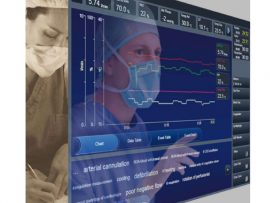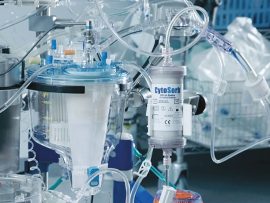Abstract Objectives As postoperative mortality for paediatric cardiac surgery is very low, we aimed to develop methods for monitoring of postoperative complication rates, given their impact upon children’s health and..
Read MoreAbstract Introduction Blood damage during cardiopulmonary bypass can trigger postoperative inflammatory responses and organ injury. Therefore, optimizing the blood circuit design to minimize damage remains essential. However, variations in venous..
Read MoreAbstract Objective To determine the state of patient blood management (PBM) practice in leading US cardiac surgery centers. Design A survey tool addressing PBM program structure and PBM program operations..
Read MoreAbstract Background Following identification of widespread Mycobacterium chimaera infections in 2013 associated with aerosolization from Sorin heater-cooler-devices (HCD), microbiological monitoring of HCDs has become mandatory in Switzerland. Methods Since 01/2016, four Maquet..
Read MoreAbstract Hemolysis is a recognized complication of a microaxial flow pump (Impella CP) support, but its incidence and associated risk factors remain unclear. We retrospectively analyzed 24 patients with cardiogenic..
Read MoreAbstract Background: The purpose of this survey was to delineate and compare patient blood management (PBM) approaches in cardiac surgery across nine Middle Eastern countries while identifying the main challenges..
Read MoreAbstract Background Maintaining optimal anesthetic depth during cardiopulmonary bypass (CPB) in pediatric patients is challenging due to altered physiology and unreliable conventional monitoring. Entropy, a processed electroencephalogram metric, offers a..
Read MoreAbstract Objective To summarize the management experience of inter-hospital transport of critically ill children with extracorporeal membrane oxygenation (ECMO) in our hospital and provide evidence for the mobile ECMO for..
Read MoreAbstract To explore whether reducing airflow and maintaining blood flow can improve the success rate of the apnea test (AT) and whether two auxiliary test strategies can improve the completion..
Read MoreAbstract Cardiopulmonary bypass (CPB) is one of the most groundbreaking medical innovations in history, enabling safe and effective heart surgery by temporarily replacing the function of the heart and lungs...
Read MoreAbstract Background Intraoperative venoarterial extracorporeal membrane oxygenation (VA ECMO) is becoming the most common mode of extracorporeal life support (ECLS) in lung transplantation (LTx). We compared rates of primary graft..
Read MoreAbstract Background Medical safety huddles are short, structured meetings for physicians to proactively discuss and respond to profession-specific patient safety concerns, with the goal of decreasing future adverse events. Prior observational..
Read MoreAbstract Background Blood is a biological, irreplaceable, and perishable resource, provided through voluntary, altruistic, and free donation in Brazil. Although blood components are widely used in hospital settings, several challenges..
Read MoreAbstract Objectives Systemic inflammatory response syndrome (SIRS) is a common complication following cardiopulmonary bypass (CPB), associated with increased mortality. We assessed the relationship between indexed oxygen delivery (DO2i) during CPB..
Read MoreAbstract Extracorporeal membrane oxygenation (ECMO) serves as a vital therapy for refractory severe respiratory and circulatory failure. With its expanding application in China and the heightened demand for high-quality medical..
Read MoreAbstract Background: Low hematocrit level is a hematological problem that is frequently encountered during cardiopulmonary bypass (CPB) in patients undergoing on-pump coronary artery bypass grafting (CABG). This study aimed to..
Read MoreAbstract The development of multi-organ failure resulting from cardiopulmonary bypass (CPB) is acknowledged as a significant contributor to increased morbidity and mortality rates during the postoperative period. This report discusses..
Read MoreAbstract Percutaneous ventricular assist devices (pVAD) decrease mortality in cardiogenic shock (CS) patients, but at a high adverse event rate. Novel pVADs need to improve cardiac power output (CPO) to..
Read MoreAbstract Extracorporeal membrane oxygenation (ECMO) use during liver transplantation is a complex and evolving aspect of critical care. This retrospective analysis presents the largest North American case series to date,..
Read MoreAbstract Purpose Coagulopathy is a common perioperative complication in aortic surgery, increasing the risk of bleeding and transfusion requirements. This study aimed to evaluate the impact of autologous plateletpheresis on..
Read MoreAbstract In clinical extracorporeal membrane oxygenation (ECMO), prolonged blood residence time in oxygenators can lead to thrombus formation and complications. Heparin-based bioactive coatings are commonly used for anticoagulation, but prolonged..
Read MoreAbstract Heart transplantation continues to be the definitive treatment option for end-stage heart failure, but its availability remains limited by the imbalance between the supply and demand of suitable donor..
Read MoreAbstract Aim and objectives To develop an extracorporeal membrane oxygenation (ECMO) training program for intensive care unit (ICU) nurses and assessing the impact of the training on the knowledge and..
Read MoreAbstract Background: The use of VA extracorporeal membrane oxygenation (ECMO) for cardiac recovery is widely adopted, with extensive publications on assessing readiness to wean from VA ECMO. Techniques to reduce..
Read MoreAbstract Background Open cardiac surgery involving cardiopulmonary bypass (CPB) triggers a systemic inflammatory response that significantly affects clinical outcomes. However, the dynamics and specific roles of cytokine release after CPB..
Read MoreAbstract Perioperative low cardiac output syndrome (LCOS) remains a significant complication in adult cardiac surgery, contributing to substantial morbidity, prolonged intensive care, and increased mortality. Its incidence is expected to..
Read MoreAbstract Background Patients on heart transplant waiting lists are often on antithrombotic (AT) drugs. Emergency orthotopic heart transplantation (OHT) when performed on such patients without optimal washout periods increases the..
Read MoreAbstract Cirrhosis was previously listed in Extracorporeal Life Support Organization (ELSO) guidelines as an absolute contraindication for venovenous extracorporeal membrane oxygenation (VV ECMO) and has since been removed. Minimal data..
Read MoreAbstract Objectives We analyzed our data to evaluate the safety and feasibility of intraoperative extracorporeal membrane oxygenation and intra-aortic balloon pump use in acute type A aortic dissection repair. Methods..
Read MoreAbstract Normothermic regional perfusion (NRP) is an effective method for recovering donation after circulatory death (DCD) organs. However, concerns remain that NRP may allow unintended cerebral perfusion despite clamping of..
Read More



















